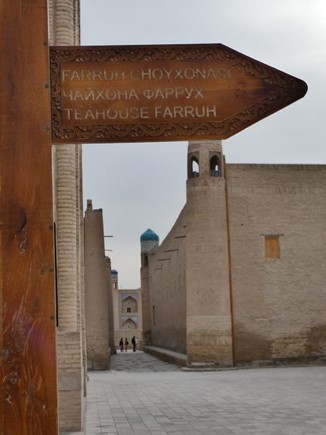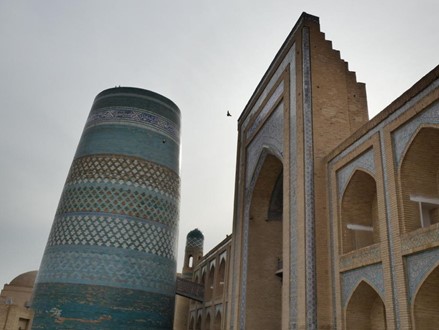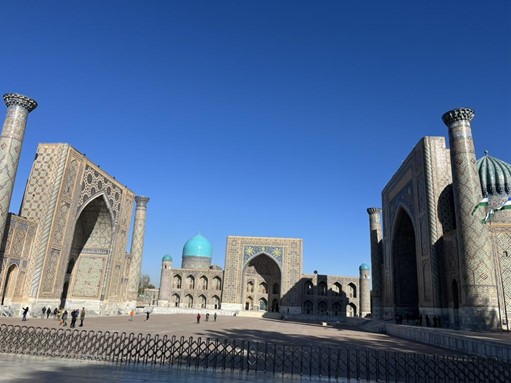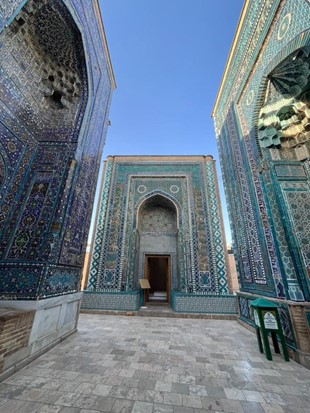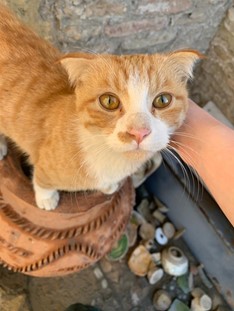By Natasha Netzorg
Central Asia has a rich history; located at the convergence of different peoples, it bears heavy influences from surrounding regions, a fact that is especially true for Uzbekistan.
Uzbekistan, unlike Kyrgyzstan or Kazakhstan, was comprised of settled people rather than nomads. There is a lot of influence from Persia and Tajikistan, including cities that were once Tajiki until Soviet-drawn borders gave those cities to Uzbekistan- and are still primarily Tajik-speaking cities today.
All around the country, ornate mosques and madrasahs with lush courtyards can be found. In the ancient, museum city of Khiva stands a mosque built over 1000 years ago and the original wooden pillars still stand within it.
Mosques are places of worship in the Muslim faith and are often segregated by men and women. Madrasahs were Islamic universities, where Muslim men would travel to learn about math, astronomy, Islam, and much more.
Minarets (where the call to worship is sung) peak out around the cities, each with their own unique stories. At night, the cities are lit up, displaying the grandiosity of the buildings, and in Samarkand, the Registan is lit with colored lights while music pours over the courtyard. At every stop, locals will greet you in Russian, English, or Uzbek to find out where you’re from and to tell you about their home.
Bazaars, such as Chorsu in Tashkent, once stood along the silk road and still sell decadent fruits, nuts, vegetables, and of course, meats. You’ll find women selling candied nuts and lots of different types of halva- a middle eastern fudge made of sesame seed paste, sugar, nuts, and spices.
Throughout Uzbekistan you’ll be greeted by Amir Timur, proudly immortalized looking over his once-empire. You’ll be able to find heaping portions of Uzbek plov (a dish made of rice, vegetables, sometimes nuts and fruit, and meat), baklava (called paklava in Uzbekistan), and you can try dill noodles or their famous pumpkin soup. Expansive fiery, pink sunsets will set over the cities, the lull of the call to worship closely behind if you’re close enough to hear it. Stray cats will wander up to say hello and get a few pets as well. Mausoleums, as ornate as mosques, tower above in Samarkand. A short trip out and one will find themselves among the mountains, filled with rocks and shrubs.
Uzbekistan is a young country, with the median age at 27. In the evening, people who were escaping the heat come to the streets where music, food, children, and animals all make an appearance. Uzbekistan’s special blend of cultures make for an exciting country that is similar to other Central Asian states but maintains a deeply unique atmosphere. Uzbekistan is currently focused on their economy and that is seen along well-cared for streets surrounded by trees, restored madrasahs and mosques once painted over from the Soviets or shaken down from earthquakes, and even their emphasis on learning English.
Visiting this historic and interesting country is an unmissable experience and the next time you’re thinking of taking a vacation, keep Uzbekistan in mind. You’ll meet interesting people, experience amazing food, and see breathtaking places unlike anything you’ve seen before. You won’t regret it. And if you visit Bukhara, outside of the four minaret madrasah, you can go and find this guy and say hello.

